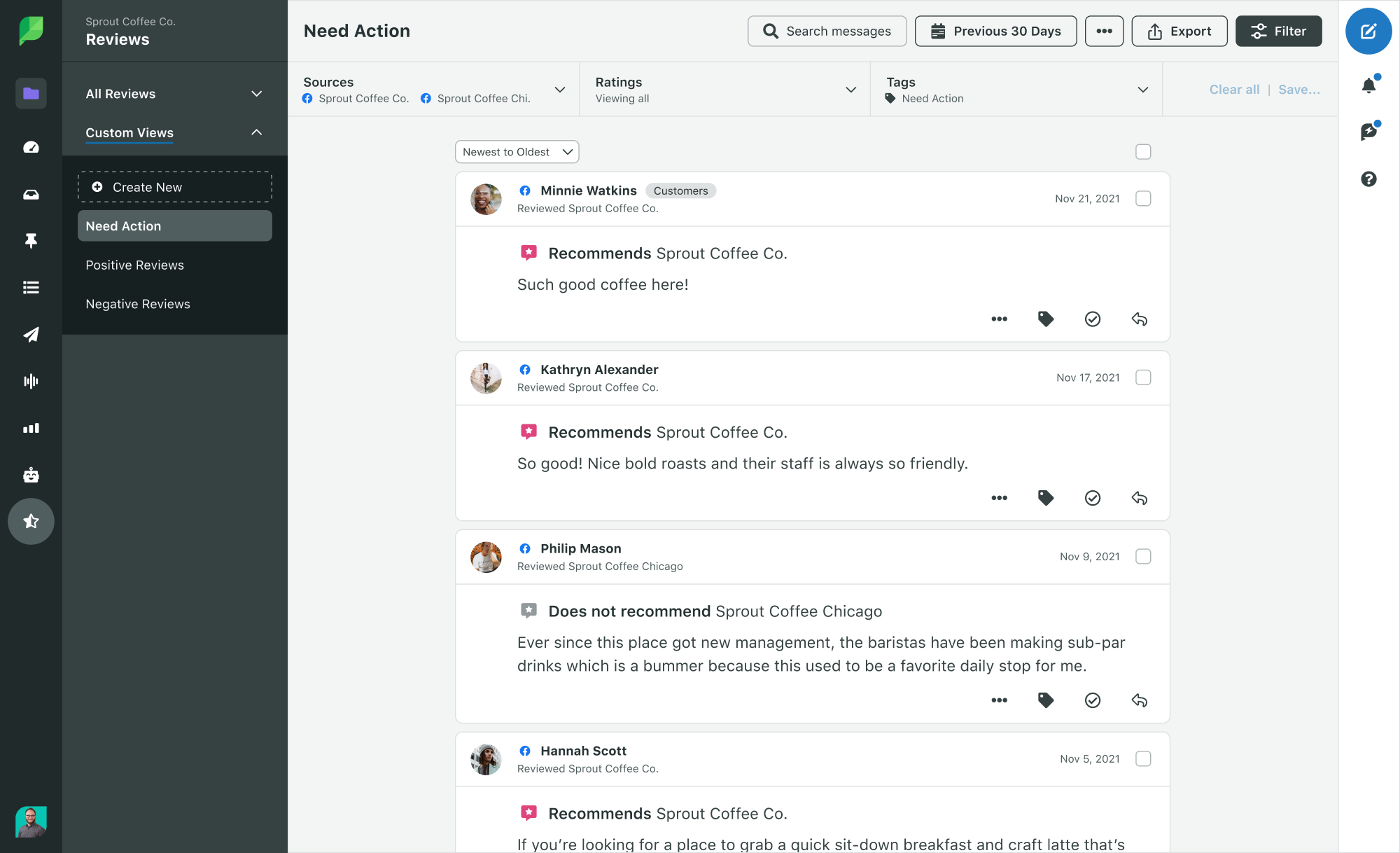Voice of customer (VoC) data is a collection of your customers’ feedback based on their experience with your brand during the customer journey.
Digital and social media have changed the way consumers interact with a brand. This has resulted in tons of feedback in the form of social media comments, reviews, posts and videos. Analyzing this user-generated content gives you in-depth insights into your target audience and emerging market trends. Yet, it can be challenging to gather VoC that is relevant and timely, manage customer data and get accurate insights.
In this article, we’ll share how to overcome these hurdles, optimize your customer experience (CX) data and draw critical insights to impact business growth.
What is voice of customer (VoC) data?
Voice of customer data refers to all customer feedback that a business gathers from its customers through social media comments, reviews, chatbot data and survey responses to understand brand perception and sentiment. Insights from this feedback can positively influence product roadmaps, customer experience, sales strategies and marketing campaigns.
Types of VoC data
VoC data comes from different sources (more on this below) and in three types: direct, indirect and inferred.
Direct data
Direct voice of customer data is gathered directly from customers. This could be through social media comments, questionnaire and survey answers, interviews, customer care calls or focus groups.
Gathering direct VoC data requires advance planning to craft effective social media or email surveys and meaningful questionnaires that lead to productive customer conversations.

Indirect data
Indirect VoC data comes from sources other than those you use to directly get in touch with your customers.
This type of data can be collected from review websites such as Google My Business or G2 and articles in online publications, as well as social listening from videos and comments on YouTube, TikTok and other platforms that mention your brand.
It’s worth noting that indirect data can come from prospects and the general public, so some may not be your customers or target audience. This means it’s best suited for a more comprehensive view of your brand perception in the market.
Inferred data
Inferred VoC feedback is behavioral insight into how a customer interacts with your brand throughout their journey. This includes their purchase history, app downloads and website behavior such as clicks, scrolls, time spent on a page or conversion rates.
All three types of VoC data are important on their own but become far more effective when combined to provide powerful, nuanced insights for data-driven marketing strategies.
What are the benefits of VoC data?
When analyzed effectively, voice of customer data provides valuable insights to influence product innovation, improve customer experience, increase sales performance and drive other advantages. Let’s get to know them more.
Product and service innovation
Voice of customer data can significantly influence your product development or market launch decisions by helping surface frequent customer requests, complaints or praise.
Machine learning and AI models help you summarize key elements and extract hidden insights so you can better prioritize your product roadmap.

Brand reputation management
Social media and review websites are great for generating brand awareness and increasing customer engagement but can also be a minefield for negative comments that damage your reputation.
Voice of customer analysis helps with real-time brand monitoring so you keep a pulse on any spikes in negative comments and monitor customer issues using keywords and hashtags. Timely intervention for effective resolutions helps you avoid escalations and build a better brand reputation.
Lead generation
Knowing your customers deeper means getting insights into their buying behavior and triggers that will boost sales campaigns. VoC insights help you develop personalized marketing campaigns and invest in ideas that attract more qualified leads.
Comprehensive market research
When you combine direct, indirect and inferred voice of customer data, you conduct comprehensive market research at a fraction of the cost and time traditional research requires. Since social listening and online data can be analyzed in seconds with an AI-powered tool like Sprout Social, you also get real-time insights along with an accurate insider’s look into historical data from inferred data such as web and purchase histories.
Customer experience
AI-driven comments analysis tools give you targeted insights into how you can be more customer-centric. They help you prioritize customer needs such as faster responses to queries, a better store ambiance or an improved user interface for your website.
How to collect, analyze and apply voice of the customer data
1. Establish your objectives
The sea of VoC data you gather will give you a number of insights but not all of them will serve your purpose. That’s why it is important to establish your business goals for the project.
Are you looking for ways to improve your revenue and sales? Do you want to build a better loyalty program? Do you want to diversify your products and offerings? Are you interested in emerging industry trends that you can leverage? The answers to these questions will help you decide your data acquisition strategy, like choosing whether you want to use only social listening data or also gather data from reviews and surveys.
Knowing what specifically you want to address will also help you streamline the conversations that will arise once you get your VoC data analysis results.
2. Collect VoC data from relevant sources
Once you have decided your approach, you must focus on pulling data from the sources that are most relevant to your business. Here is a list of data sources that you can use.
Social media listening
Social listening analyzes conversations and trends happening around your brand and industry as a whole. Social VoC data is great for monitoring brand sentiment, understanding your customers’ needs and keeping an eye on your competitors—all of which will enable you to make better business decisions.
Social listening aggregates data around key topics and trends, giving you the context to layer meaning and relevance onto what your customers tell you. Listen to learn why, where and how conversations are happening about your brand, and what people think when they’re tagging or mentioning you directly.
If you use a tool like Sprout, you will see how aggregated social data gives you an exact picture of how people are experiencing your brand.

Surveys
We’ve all experienced surveys in some form—whether it’s the dreaded YouTube survey that pops up when you want to view a new video or the email survey you get after a purchase.
Surveys can be one of the most difficult ways to collect VoC data because the results depend a great deal on how targeted the questions are, the participants themselves and responses that may be either too broad or cryptic. But when done right, survey responses inform how to build better loyalty programs, boost quality leads and revitalize a stagnating business.
When surveys contain a mix of quantitative metrics (such as star ratings) and open-ended questions like in the example below, it might be difficult to extract cohesive and valid insight from responses. Intelligent tools like Sprout use natural language processing (NLP) and semantic clustering to overcome this barrier and extract precise information from various responses.
Online customer reviews
Knowing how to ask for customer reviews is the first step to leveraging this data source for business insights. Online reviews from customer and product forums such as Yelp, G2, Capterra, Google My Business, etc. are a great place to find the pros and cons of your products and offerings—including unexpected ones.

Live chat and chatbots
Live chats and chatbots help you understand recurring customer queries and issues, and also collect feedback on how helpful the experience was or where there’s room for improvement.
In Sprout Social, you can build chatbots to create automated answer flows for common questions and customer care issues such as tracking orders or finding locations. These chatbots integrate with Sprout’s Smart Inbox so team members are alerted when human assistance is needed.

Website behavior and purchase history
Website analytics give you data on how customers and prospects are landing on your pages and interacting with your web content: time on page, visit history and other events like conversions.
These metrics guide you to improve your web user interface, develop engaging content for better conversions and work on your search engine rankings.
Similarly, insights from your customers’ purchase history help you build personalized ads, emails and relevant offers.
Sales calls and call center data
Sales calls provide information about what prospects are looking for in your product and where you stand compared to the competition. Similarly, listening to customer service calls that are recorded for quality assurance give you a good idea of the common issues your customers face (and what you can do to improve their experience).
Emails
Emails sent to customer service are often a gold mine of pertinent information you can use to improve customer satisfaction. Customers may write about issues they are having with logistics, returns and warranties, product inadequacies or even to thank you for a job well done.
All these messages are important, and if you’re using an efficient machine learning model, you can easily isolate key topics and themes that give you guidance for improved operations.
Once you’ve zeroed in on which data sources are the most relevant to you, you must make a list of important hashtags, keywords, phrases and topics to get fine-grained results. Sprout enables you to build queries to match what you want to cover, so the results are tailored to your brand’s needs.

3. Analyze the data for insights
To extract VoC insights accurately, you need to take into account qualitative and quantitative metrics. Here’s a rundown of what these may look like.
Quantitative metrics
Net promoter score (NPS)
Your NPS measures how likely a customer is to recommend your business to a friend or colleague. It is usually collected through customer surveys and interviews where respondents choose a rating on a scale of 1–10.
Respondents are segmented into three categories: promoters (those who scored 9 or 10), passives (who scored 8 or 7) and detractors (who scored 0-6). Your final NPS is the percentage of customers who are promoters minus the percentage of detractors.
Customer effort score (CES)
CES measures the effort the customer has to make in completing a transaction to their satisfaction. Respondents select a rating on a scale from one to seven (strongly disagree to strongly agree). The final score is calculated by the percentage of customers that land in the middle and “somewhat agree.”
Social engagement metrics
Likes, dislikes, post shares, number of comments and retweets, all are key social media metrics that tell you how well your brand is performing. Use social analytics to improve post-engagement rates and increase your share of voice. This helps you build a stronger brand presence and increase customer satisfaction by improving upon issues highlighted by your customers.

Qualitative metrics
Voice of customer sentiment analysis
Sentiment analysis is an AI-powered data science technique that measures how positive, negative or neutral customers are towards you. Sprout Social’s sentiment analysis capability automatically captures topics, themes and aspects from thousands of social listening data in seconds to give you buried insights.
You can view emerging market trends as well as sentiment scores based on time periods and sources (Facebook, Twitter, TikTok, etc.). This breaks down how your brand perception differs from one data source to another and what are the contributing factors.

Sprout’s Topic Summary feature gives an overview of traditional key performance indicators (KPIs) like volume, potential impressions and engagements to quantify what conversations are occurring. You’ll also find sentiment, calculated by the percentage of positive, negative or unrated messages for your Topic.
Our Conversation Tab aggregates conversations, keywords and hashtags that are frequently mentioned with your Topic. The word cloud feature visualizes which keywords are the most prominent, so you know where to focus your efforts.

You can create specific filters for those keywords, clear qualitative data and use the insights to make new menu decisions. You can also create filter functions for locations, demographics, message types and more, to get granular and sharper insights.
4. Take action on VoC feedback
There are many key ways to use VoC insights to strengthen your marketing strategy, such as the following:
Build buyer personas
Voice of customer analytics help you categorize customers based on their buying behavior. Use this to build buyer personas and zero in on the types of content that will appeal to them the most, what networks they trust and what pain points they face. This insight will strengthen your sales strategy and lead to better conversions.
Identify issues
Identify recurring issues that affect your business processes, website experience, logistics and supply chain. Then take corrective action.
Prioritize product roadmaps
VoC data insights help you prioritize high-impact product decisions and course-correct when needed to better meet your customers’ needs and expectations.
Build targeted marketing campaigns
Chalk out your paid and organic marketing efforts with VoC insights. Build relevant ads that bring in an impressive return on investment, choose the right platforms to publish them on and create a robust SEO strategy.
Adjust brand messaging
VoC data gives you insights into customer sentiments related to your brand messaging including your ad creatives. This helps you adjust your messaging according to market drivers and be in tune with cultural sensitivities in a global environment.
Choose brand ambassadors
Social media metrics also inform which social influencers are the best fit for your brand. Monitor their content based on hashtags and keywords to ensure your brand ambassadors stay aligned to your brand.
Revamp loyalty programs
VoC insights give you the opportunity to build better, more relevant brand loyalty programs by tailoring them to customer demographics and priorities.

Three voice of customer examples to learn from
1. Inspire Medical Systems enhances customer support using VoC insights
Inspire uses Sprout’s social media management tool to reach out to millions of people who suffer from sleep apnea but are unable to use traditional treatments. Customers have thousands of queries and need prompt assistance. This need saw a significant increase during the COVID-19 pandemic.
To meet this challenge, Inspire used Sprout’s COVID-19 Inbox Rule Template to identify relevant messages to enable their team to provide customers with critical support that was timely and efficient. By listening to customers and understanding their common concerns, Inspire was also able to develop new assets and response scripts covering telemedicine and patient safety.
2. Lowe’s Hotels identifies opportunities to drive business efficiency
Hotel company Lowe’s uses customer feedback to deliver exceptional services to its customers. With Sprout’s Smart Inbox, Lowe’s monitors keywords, hashtags and locations to discover unique opportunities to improve their service and increase customer engagement.
The company also employs VoC insights to discover valuable business intelligence and improve its business processes, creating time efficiencies and building deeper customer relationships.
3. Allegiant Air transforms customer care strategy by listening to VoC
Allegiant Air uses voice of customer data to alleviate its customer service volume, retain customers and build brand loyalty. With Sprout’s Tagging system that features rules built around keywords, Allegiant quickly identifies a customer’s need and responds to it. They have been able to build smoother team collaboration, identify areas that need more focus and found new ways to put the customer first.
Start listening to your customers’ voices today
Customer satisfaction is crucial to having return customers and a superior brand reputation that boosts your financial performance through recurring revenue.
An intelligent social media management tool like Sprout helps you do this and more. Gather and analyze large amounts of VoC data quickly and accurately to surface business-critical insights, from hidden market trends to customer preferences, and implement those insights into your social strategy in one platform.
Take advantage of our free trial and find targeted ways to improve your business.
The post How to use voice of customer data to grow your brand appeared first on Sprout Social.